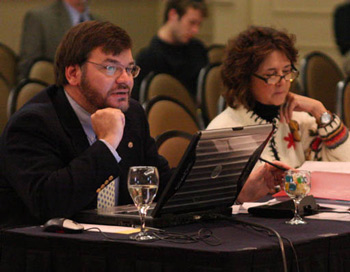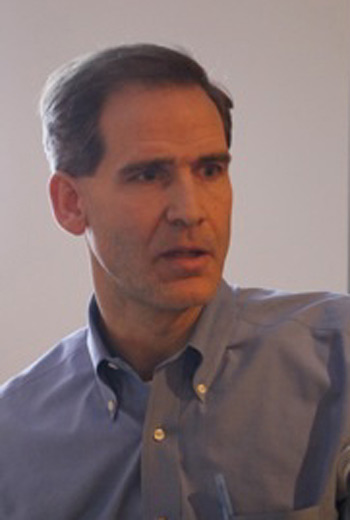GROUNDFISHERMEN FACE ECONOMIC DISASTER
continued from Home Page

Steve Cadrin said the conservative catch limits in place now were based on a stock assessment that was published in 2008, before catch limits were in place and before their effect could be understood. ©Photo by Sam Murfitt
With regard to direct relief, Patrick wrote that “first, the initial quota allocation has left two-thirds of the fleet with 50 percent to 60 percent lower allocation than they had fished in prior years, and second, the broader market is non-functioning and has resulted in the inability of fishermen to buy, sell and lease shares for a host of unforeseen reasons. The full magnitude of this impact from these under-allocations and the failure of the market to function effectively were unforeseen and, while the market may correct itself over time, it needs immediate attention at this point.”
The report was written by the state's Division of Marine Fisheries in conjunction with the Massachusetts School of Marine Science and Technology, through the Massachusetts Marine Fisheries Institute. Titled “A Report on Economic and Scientific Conditions in the Massachusetts Multispecies Groundfishery,” the report concludes that the groundfish industry’s transition to a sector-based catch share management system over the past year, since the May 1, 2010 implementation of Amendment 16 to NEFMC’s Groundfish Management Plan, “caused unforeseen major shifts in the distribution of quota (and income) resulting in $21 million in direct economic losses and foregone yield of $19 million for the Massachusetts groundfish fishery. “Scientifically-valid alternative reference points have been identified which can trigger increases in annual catch limits without sacrificing conservation. These increases are particularly helpful with regard to raising limits for choke species.”
A “choke species” is one whose harvest remain severely limited; when the catch limit of a choke species is reached, all fishing in a sector must halt, regardless of whether or not the catch limits of healthier species have been reached.
“Landings and revenue data available for the first five months (May-September) of the 2010 fishing year show the numbers are comparable for the same period last year and appear to indicate potential economic health in the groundfishery as a whole,” the report says. But the data mask unforeseen economic impacts at the local level, partly through consolidation, the report says.
“Of 385 Massachusetts groundfish boats that have joined sectors, 56 percent have not yet been active in the fishery this year,” the report says. “This compares to 46 percent inactive at this time last year. The transition to catch shares has created gain for some fishing businesses, but low quota allocations represent an economic emergency for a significant portion of the fishing community. For example, a comparison of 2010 annual catch entitlements to actual landings in recent years shows as much as two-thirds of fishing permits were allocated 50-60 percent less than their 2007-2009 average annual harvest. This reduction in allocation represents lost revenue of $21 million for this portion of permit holders.”
The report says the situation can be mitigated by raising catch limits. Furthermore, raising catch limits is scientifically justified. The determination of annual catch limits incorporates several buffers to account for uncertainty in fishing and biomass estimates, the report says. Smaller uncertainty buffers can be used in order to raise catch limits while still protecting stocks. In the same way, catch limits can be increased for the “choke species” – Georges Bank cod and yellowtail flounder, Gulf of Maine cod and winter flounder, and southern New England winter flounder – while also preserving conservation goals.
But in his January 7 response, Locke said the report “does not present new scientific data that would justify increasing the catch limits….In the absence of new scientific data, I am consequently unable to exercise my emergency rule authority in response to your request.” Locke also denied the request for direct economic relief. He wrote, “the data provided are insufficient to warrant either a fishery disaster or a commercial fishery failure…”
At the January 25 meeting, Lang, Rothschild and others said that Locke’s reply was insufficient. “We thought that it was a reply, and not really a response,” said Rothschild. In addition to members of the two councils, the meeting drew fishermen, fish processors, conservationists, fishery scientists, and federal, state and municipal officials from Maine, Massachusetts, New Hampshire and Rhode Island.
Rothschild said that Locke’s answer was based on the fishery’s overall increase in revenues. But, he said, Locke did not address the changing economic and social conditions in the fishing communities. Not all fishermen are doing well and the industry as a whole is underfishing the total allowable catch for many species. Over the past few years, he said, the industry has landed only a third of its total allowable catch. That adds up to a shortfall of 100,000 tons of fish that goes unharvested, which translates into $30 million at the dock and a billion dollars or more in the general economy.
“Fishing families are feeling severe stress and financial strain,” said Lang. “We‘re watching a human crisis take place along the East Coast as a result of the catch share system.” An increase in the catch share allocations would allow fishermen to earn a living and not put the resource in danger. “You’re killing a culture, a heritage and an economic driver in all our port cities by way of a calculation that simply needs to be adjusted,” Lang said.
Gloucester, Massachusetts, fisherman Vito Giacalone said that, in his area where there are two active sectors, catch share allocations are at about 30 percent of what they were in recent years. The cost of keeping and maintaining a vessel is preventing many fishermen from leasing more quota, he said. “We’ve only been eight months into sectors, but a third of the vessels will be insolvent next year,” Giacalone said. An increase in allocation would help to relieve pressure from the bottom up, he said.
Steve Cadrin, chairman of the NEFMC’s science and statistical committee and a contributor to the groundfish report, said that catch limits can be increased without hurting the resource. “Our report concluded that there’s scientific latitude to increase the annual catch limits for all groundfish species,” Cadrin said. The conservative catch limits in place now were based on a stock assessment that was published in 2008, before catch limits were in place and before their effect could be understood. “We’re requiring fishery management to build stocks past where we need to legally,” he said.
The issue is complicated by the lack of a good definition of overfishing, he said. In its place, he said, scientists have come up with a “safe approximation” that is too conservative and “doesn’t seem appropriate in the face of an economic disaster,” he said. University of Massachusetts economist Dan Georgianna, who also contributed to the report, said that, while the distribution of revenue is working for some boats in the fleet, it is not working for others. “Personally, as an economist, it strikes me as a serious problem when only 25 or 30 percent of the allowable catch, of the quota, is actually landed,” Georgianna said. “I think that’s a terrible, terrible waste.”

“….You won’t want a couple of factory boats to harvest this stock, processing it, treating it, breading it and putting it in a freezer for [a dealer] to ship around the world. You want the best value, it should be harvested by a fleet of a thousand boats in four major ports every day.” —Peter Ramsden ©Photo by Sam Murfitt
Georgianna said it was up to the National Marine Fisheries Service and the National Oceanic and Atmospheric Administration to take responsibility to improve the situation. “I don’t think it’s sufficient to say revenues are up so everything’s okay,” he said. “There’s this disconnect between saying, ‘Revenues are higher, everything’s fine,’ and people in the business and on the docks saying, ‘No, everything is not fine.’” Waiting for the catch share system to settle out is not fair to the fishermen, he said.
Peter Ramsden, fourth-generation owner of the Boston and New Bedford processing firm Foley Fish Co., said he continues to employ 85 people but could be employing more if fishermen were allowed to catch more. “I don’t worry about where to find the next customer. I don’t worry about whether there’s enough fish in the sea,” Ramsden said. “I worry about whether there will be another generation of fishermen to get into this business….You won’t want a couple of factory boats to harvest this stock, processing it, treating it, breading it and putting it in a freezer for [a dealer] to ship around the world. You want the best value, it should be harvested by a fleet of a thousand boats in four major ports every day.”
